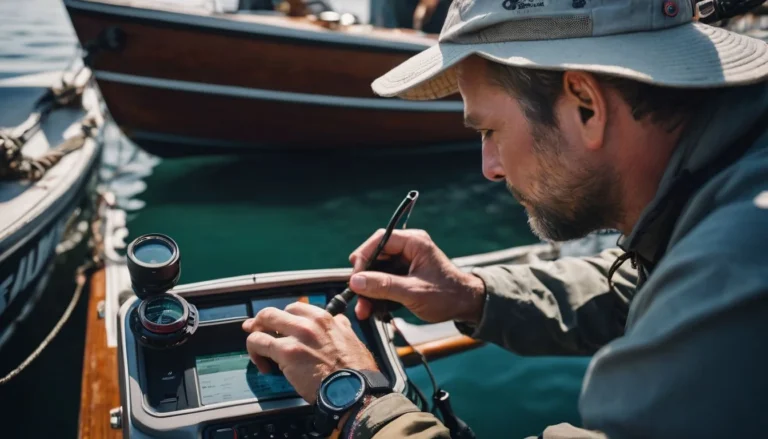Why Is My Garmin Depth Finder Flashing?
Anglers often find themselves puzzled when their Garmin depth finder starts flashing, leaving them uncertain about the water’s true depth.
This issue might stem from the device struggling to maintain a consistent connection with the bottom terrain.
Our blog post will guide you through understanding this technical hiccup and provide practical solutions to keep your fishing trips on track.
Stay tuned for clear insights that could make all the difference out at sea!
Key Takeaways
- A Garmin depth finder might flash due to a loss of signal, often because the boat is moving too fast or the transducer has lost contact with the bottom.
- Transducers must be properly aligned, securely mounted, free of debris, and correctly installed at an appropriate depth for accurate readings; incorrect settings can cause flashing.
- Adjusting frequency settings can improve performance; higher frequencies work best in shallow water, while lower frequencies are suited for deeper waters.
- Garmin fish finders like the Striker Plus series can detect depths up to 2,300 feet in freshwater and 1,100 feet in saltwater when paired with a compatible transducer.
- Slowing down your vessel or adjusting the gain from automatic to manual on your device could stop it from flashing and provide more reliable depth information.
Understanding the Garmin Depth Finder Flashing Issue
When your Garmin depth finder begins to flash, it’s often a sign that the device is encountering difficulties in providing accurate underwater readings. Delving into this common issue helps unravel why disruptions occur and how to restore clear depth measurements.
Reasons for Flashing the Depth Finder
A flashing depth reading on a Garmin depth finder can leave boaters scratching their heads. Let’s uncover the factors that might cause your device to display unreliable information.
- Loss of Signal: One common reason for a flashing depth finder is the loss of the signal from the bottom. The device may struggle to find and maintain a solid connection with the seabed, leading to intermittent readings.
- Speed Sensitivity: Reports indicate that boat speed affects depth readings. Some users have found that slowing down their vessel stops the flashing and stabilizes the display, suggesting a link between speed and signal clarity.
- Transducer Problems: Issues with the transducer, such as an improper connection to the hull or damage, can disrupt its ability to send and receive signals effectively, causing flashing indicators.
- Incorrect Settings: If your fish finder’s settings are not configured correctly—for example, if you’re using a frequency not suited for your current water conditions—it can result in erratic readings.
- Shallow Water Alarms: A safety feature designed to alert boaters to shallow waters, these alarms can sometimes be overly sensitive or malfunction, resulting in a flashing display even in deeper waters.
- Interference: External factors like other electronic devices, large structures under water, or heavy sediment can interfere with signal transmission, leading to inconsistent displays.
Loss of contact with the bottom
Sometimes, your Garmin depth finder might start flashing because it has lost contact with the bottom. This can happen if the boat is moving too fast or if you’re in extremely deep water where the sonar signals can’t reach the bottom and bounce back effectively.
Think of it like shouting across a vast canyon—if you’re too far away, your echo won’t make it back to you.
Issues with transducer placement can also cause this problem. If the transducer isn’t properly connected to the hull or if it’s become covered in debris, its ability to send and receive signals becomes compromised.
Keeping an eye on these components ensures that your depth readings remain consistent and reliable as you navigate through different waters. It’s not just about slowing down; sometimes a little maintenance or repositioning does the trick to regain that crucial contact with what lies beneath your vessel.
The Role of the Transducer in Depth Reading
Central to any depth finder’s performance, the transducer is akin to an underwater detective, meticulously scanning and translating echoes into readable depths on your Garmin device.
Its precise functioning is paramount, as it directly influences the accuracy of the depth readings displayed.
Location and mounting issues
A Garmin depth finder relies heavily on its transducer to deliver accurate readings. Incorrect location and mounting of the transducer can lead to a flashing display, signaling problems below the surface.
- Transducer Alignment: Check that the transducer is aligned properly on your boat’s hull. Misalignment can cause inaccurate readings as it might not be positioned in the water correctly, leading to erroneous depth data.
- Secure Mounting: Ensure that the transducer is securely attached. A loose transducer may tilt or vibrate, causing intermittent contact with the water and inconsistent depth information.
- Clean Surface: The part of the hull where you mount the transducer should be clean and smooth. Any debris or growth beneath it can disrupt signal clarity, resulting in a flashing finder.
- Correct Installation Depth: Position your transducer at an appropriate depth relative to the waterline. If it’s too high, it may lose contact with the water when you’re moving fast; if it’s too low, it could cause drag or get damaged.
- Transom Angle: Adjust for any angle on your boat’s transom if that’s where you have mounted your device. An incorrect angle could direct sonar beams away from the sea bed, impairing depth detection.
Frequency Setting Adjustments
Troubles with your Garmin depth finder can often stem from incorrect frequency settings. Adjusting these settings can stabilize the display and provide more accurate depth readings.
- Verify the current frequency setting on your device. Most Garmin fishfinders offer dual – frequency transducers that you might need to toggle between high and low frequencies.
- Choose a higher frequency for detailed images in shallower water. This makes it easier to identify objects, structures, or fish beneath your vessel.
- Opt for a lower frequency in deeper water where greater sonar penetration is needed but less detail is required.
- Experiment with different frequencies to determine which provides the best performance for the water conditions you’re encountering.
- Consult your Garmin manual for specific guidelines on setting or adjusting frequency based on model specifications.
- Engage the gain control feature; sometimes switching from automatic to manual gain can enhance the depth sounder’s consistency and reduce flashing issues.
- For vessels frequently traversing shallow waters, consider disabling the shallow water alarm, as some users do, and rely instead on consistent multiple readings at adjusted frequencies for accurate depth gauging.
What Depth Can Garmin Fish Finders Measure?
Garmin fishfinders are engineered to probe the water’s depths, giving anglers an edge by revealing what lies beneath their boats. They boast capabilities that can detect water down to impressive depths.
For instance, models like the Garmin Striker Plus series can measure up to 2,300 feet in freshwater and 1,100 feet in saltwater when equipped with a compatible transducer. This technology ensures that whether you’re fishing a local lake or exploring offshore waters, you have access to critical depth information.
These devices use sophisticated sonar technology that sends sound waves into the water and listens for their return after bouncing off fish and underwater structures. With this powerful tool at your disposal, identifying potential hotspots teeming with aquatic life becomes a more straightforward task.
It’s important for users experiencing flashing issues on their device to consider these capabilities since inaccurate readings might not be due to the limitations of depth measurement but other factors related directly to device settings or environmental conditions.
Potential Solutions for the Flashing Depth Finder
If your Garmin depth finder’s persistent flashing has left you baffled, fear not; there are strategic maneuvers and technical tweaks that can restore the clarity of your aquatic insights.
Delving into these solutions could be the key to uninterrupted and accurate readings below the surface.
Slowing down the vessel
Slowing your boat can sometimes be the quick fix you need for a flashing Garmin depth finder. As you reduce speed, the device often stops flickering and provides updated information.
This seemingly simple action gives your equipment more time to process signals from below the water’s surface.
Check to see if this change in pace gives your transducer a better chance at maintaining consistent contact with the bottom. Many boaters have discovered that easing off on the throttle leads to more reliable readings, ensuring they don’t lose track of important underwater details.
Keep an eye on your depth finder as you decelerate; observe whether slowing down smooths out its performance.
Checking and Adjusting Transducer Settings
The proper setup of your Garmin depth finder’s transducer is vital for accurate readings. If your device’s display keeps flashing, it may signal that the transducer requires some attention. Here are the steps you need to take to check and adjust your transducer settings:
- Inspect the transducer: Look for any physical damage or growth like algae on the transducer’s surface, as these can interfere with performance.
- Confirm proper mounting: Ensure that the transducer is mounted securely and positioned correctly according to the manufacturer’s guidelines, typically parallel to the waterline.
- Check connections: Verify all cables from the transducer to your depth finder are firmly connected and have no visible signs of wear or damage.
- Manage gain settings: Adjusting the gain from automatic to manual may provide more consistent depth readings, especially if auto mode isn’t compensating effectively for water conditions.
- Test different frequencies: Some Garmin models offer dual-frequency settings; experimenting with these can help find a more stable reading.
Conclusion
Having a Garmin depth finder that flashes can be frustrating, but it’s often a signal that something needs your attention. Double-checking your transducer’s position and settings could resolve the flashing quickly.
Remember to keep an eye on your speed, as going slower might just do the trick. Take these steps, and you’ll likely enjoy smooth sailing with accurate depth readings ahead. Keep exploring solutions until your device reads like a charm!
To understand more about the capabilities of your device, read our detailed guide on “What depth can Garmin fish finders measure?”
FAQs on Garmin Depth Finder Flashing
Gary Burrell
Born in 1989, Gary Burrell is an Electrical Engineering graduate from the University of Tennessee. With 20+ years of experience, he has transitioned from engineering roles to becoming the Chief Content Editor. Gary’s unique blend of technical knowledge and editorial expertise has made him an essential figure in content creation, ensuring clarity and accuracy. His journey from an engineer to an editor showcases his adaptability and commitment to continuous learning.




